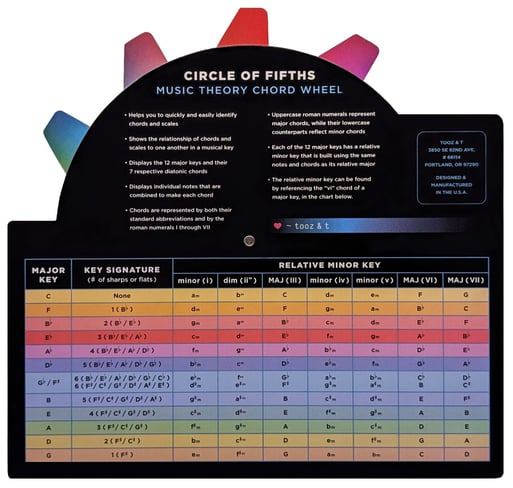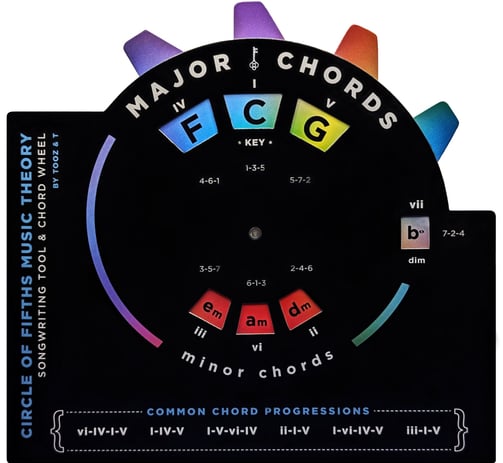
Unlock Your Musical Potential
Our Circle of Fifths Songwriting Tool helps you dive into Music Theory with ease and creativity. Introducing the Circle Of Fifths Music Theory Songwriting Tool & Chord Wheel
In a traditional musical key, a chord progression is a series of chords played in a specific order.
Each chord in a chord progression has it's own unique sound and function.
The order in which they are played is related to their Scale Degree, and is intended to create a sense of harmonic movement and resolution.
Here are some considerations for building chord progressions when writing songs or crafting a piece of music :




SCALE DEGREE # 1 - TONIC :
Tonic (I) is home base, where the music feels most stable and will typically define the key of the song. This is also known as the tonal center.
A piece of music will often begin and end with the tonic, ultimately resolving the tension that builds as it moves through other chords in the key.
SCALE DEGREE # 2 -SUPERTONIC :
Supertonic (ii): The supertonic creates tension that wants to resolve to the tonic or mediant. It's often used as a passing chord or to add color to the progression.
SCALE DEGREE # 3 - MEDIANT :
Mediant (iii): The mediant adds color and interest to the progression, often used as a passing chord or to create tension that resolves to the subdominant or dominant.
SCALE DEGREE # 4 -SUBDOMINANT :
Subdominant (IV): The subdominant creates tension that wants to resolve back to the tonic, adding variety and interest to the progression.
SCALE DEGREE # 5 - DOMINANT :
Dominant (V): The dominant creates strong tension that wants to resolve back to the tonic, often used as a setup for the final resolution.
SCALE DEGREE # 6 - SUBMEDIANT :
Submediant (vi): The submediant can add a touch of sadness or introspection, often used in minor keys or to create contrast in major keys.
SCALE DEGREE # 7 - LEADING TONE :
Leading Tone (vii°): The leading tone creates strong tension that resolves up to the tonic, often used as a dramatic flourish before resolving.
A typical chord progression might move from I to IV to V, back to I.
This is a popular progression that uses tonic-subdominant-dominant functions, creating a sense of tension and resolution.
ii-V-I is a progression that uses supertonic-dominant-tonic functions.
vi-IV-I-V is a variation of I-IV-V with an added twist from the submediant.
These are just a few examples, but there are many other ways to build a chord progression within a key
( and wouldn't you know it, we've provided a few of these and more to get you started ~
Grab your Circle Of Fifths Music Theory Songwriting Tool & Chord Wheel by tooz & t ! )


Scale degrees are the numbered positions of each note and chord within a musical scale.
In a diatonic scale, there are seven scale degrees, numbered 1 through 7, corresponding to the seven natural tones in the scale.
EXPLORE :
© 2025. All rights reserved. tooz & t, LLC
Spread the word via your favorite platform
ENGAGE :
KEEP IN TOUCH :
For General Questions and/or Wholesale Inquiries, please contact us directly by email : tntmusic@toozandt.com
For General Questions and/or Wholesale Inquiries, please contact us directly by email : tntmusic@toozandt.com